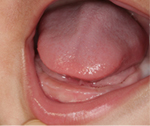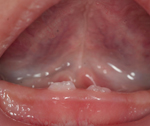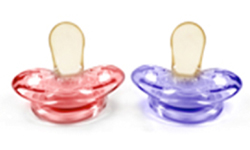Baby Oral Health for Parents

 Once your feeding routine is established, begin using a moist soft washcloth to wipe your baby’s gums every night and after feedings. This routine can help your child get used to having someone in his/her mouth and may make it easier to begin tooth brushing.
Watch Video
Once your feeding routine is established, begin using a moist soft washcloth to wipe your baby’s gums every night and after feedings. This routine can help your child get used to having someone in his/her mouth and may make it easier to begin tooth brushing.
Watch Video
 Begin brushing your baby’s teeth as soon they start coming in. Use a soft toothbrush and a very small amount of fluoride toothpaste.
Begin brushing your baby’s teeth as soon they start coming in. Use a soft toothbrush and a very small amount of fluoride toothpaste.
 There have been many answers to this question. The latest advice comes from the American Dental Association (ADA). The ADA says to start using fluoride toothpaste when your baby’s first tooth comes in whether your child has a high risk for getting cavities or not.
There have been many answers to this question. The latest advice comes from the American Dental Association (ADA). The ADA says to start using fluoride toothpaste when your baby’s first tooth comes in whether your child has a high risk for getting cavities or not.
Swallowing fluoride toothpaste can be a concern. It is important to use the correct amount of toothpaste—a smear the size of a grain of rice. Children are not able to spit well until 3-6 years of age. Using fluoride toothpaste in a very small amount will ensure your child swallows little or no toothpaste.
Your baby may get fussy, suck on his/her fingers, rub the gums and side of the face, and drool. Teething does not cause high fever or diarrhea. Call your doctor if your baby has fever or diarrhea symptoms for more than a day or two.
Your child may experience some discomfort with teething. You should avoid using products like Baby Orajel because in rare cases, it can cause a child to turn blue and stop breathing. Instead, your child can use a safe teething toy. Safe toys are one-piece, have no paint on the outside, and are bigger than the hole in a roll of toilet paper. Additionally, acetaminophen (Tylenol) at appropriate doses can be used for discomfort.

Your child can use a pacifier after he/she is feeding well and there are no feeding problems. Using a pacifier after age one month may help protect against SIDS (Sudden Infant Death Syndrome). For your baby’s safety, avoid using a string around the neck to hold the pacifier.
Look at the age on the label (0-6 months, 6 months-18 months, 18 months+) to make sure you get the right size for your baby’s comfort. Look for pacifiers with air holes. Check periodically to make sure the pacifier remains in one piece. Disinfect the pacifier regularly or replace it according to the directions on the label.
Stop use of a pacifier after one year. Using a pacifier past one year of age may cause your child to have teeth that do not fit together properly. It may also increase the risk of your child getting ear infections.
Some parents remove all pacifiers at once and pretend to have the child give them to a baby being born. You can also begin to cut the tips of the pacifier so the child loses interest. Praising the child whenever they put the pacifier down can help. Use a substitute item such as a stuffed animal or blanket to provide comfort.

About 40% of children will begin school with a history of cavities. Early visits to the dentist can help prevent cavities. Make the first dental check-up around the child’s first birthday. At this time, you will learn about how best to prevent cavities to ensure your child remains cavity-free.
To find a dentist near you, click on the following link: http://www.aapd.org/finddentist/search/. If you cannot find a dentist to care for your child, speak to your doctor. Your doctor may know of a dentist who could treat your child. Many times doctors can provide preventive dental care in areas where finding a dentist may be difficult.
Baby teeth are used by the child to chew foods. They also make for a pretty smile. Baby teeth are important because they hold space for the adult teeth to come in. Early loss of teeth can affect the way other teeth come into the mouth. For all of these reasons, it is important that baby teeth do not get cavities.
Fluoride is a “vitamin” for teeth that helps make them more resistant to tooth decay. A little bit of fluoride is good, but too much is not. Your baby will not get enough fluoride from breast milk alone even if you drink water with fluoride. If using formula, mix the powder with water that has fluoride. Most city water sources contain fluoride and will ensure your baby gets enough fluoride to strengthen the teeth. Pre-mixed formula also has fluoride.
If your family uses well water, it may have too little or too much fluoride. Ask your doctor or dentist to run a test to see how much fluoride is in your well water. Click here to read about other sources of fluoride.
You may use a water filter at your house. There are some types of filters such as the “reverse osmosis” type that remove fluoride. However, most types of filters (eg, Brita, Pur, etc.) do not remove the fluoride.
Bottled water often has lower fluoride levels than city water. You can use bottled water if you are concerned about your baby getting too much fluoride. Avoid bottled water that has no fluoride.
You should not give your child juice until after the first birthday unless your doctor tells you otherwise. Children do not need juice, and juice is not considered a healthy food. But, if you want to give children juice after 1 year of age, they should not drink more than 4-6 ounces (1/2 a cup or 1 juice box) of juice per day. Juice has a lot of sugar that can coat the teeth and cause tooth decay. If you dilute the juice (add water), give it to your child only during meal times. Between meals, give your child only water to drink. It is best for children to drink the juice at one sitting with a meal rather than sipping on it all day. This will help prevent cavities in teeth.
 Too much snacking promotes cavities. Snacks should be infrequent and should include healthy food choices such as fresh fruit, vegetables, cheese, and yogurt. Avoid sticky types of food (fruit roll ups, dried fruit, gummy vitamins) because they stay on teeth for a long time and promote tooth decay. After age 1, it is best to have scheduled meals (3 per day) and 1 scheduled snack between meals.
Too much snacking promotes cavities. Snacks should be infrequent and should include healthy food choices such as fresh fruit, vegetables, cheese, and yogurt. Avoid sticky types of food (fruit roll ups, dried fruit, gummy vitamins) because they stay on teeth for a long time and promote tooth decay. After age 1, it is best to have scheduled meals (3 per day) and 1 scheduled snack between meals.
 The American Academy of Pediatrics recommends changing to a sippy cup by the first birthday. It is important to think about what goes in the sippy cup when making the change from the bottle. Toddlers should drink water between meals and milk, juice or water during meal time. Make sure your toddler is not having more than 4-6 ounces of juice per day or 16 ounces of milk per day.
The American Academy of Pediatrics recommends changing to a sippy cup by the first birthday. It is important to think about what goes in the sippy cup when making the change from the bottle. Toddlers should drink water between meals and milk, juice or water during meal time. Make sure your toddler is not having more than 4-6 ounces of juice per day or 16 ounces of milk per day.
 Falls and injuries to the mouth are common as children begin to explore their world by crawling and walking. Having a dentist for your child by his/her first birthday gives you a place to go to if these common injuries happen. If your baby falls and hurts his/her mouth, contact your dentist. If you do not have a “dental home”, contact your doctor.
Falls and injuries to the mouth are common as children begin to explore their world by crawling and walking. Having a dentist for your child by his/her first birthday gives you a place to go to if these common injuries happen. If your baby falls and hurts his/her mouth, contact your dentist. If you do not have a “dental home”, contact your doctor.
- Remove or protect corners of tables from the child’s play area
- Do not allow your child to walk or run around with bottles, pacifiers, or sippy cups. In the United States, there are more than 2,200 emergency room visits per year because of injuries from these items.
- Protect your bathtub nozzle with a cover
- Cover electrical outlets